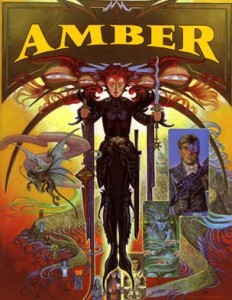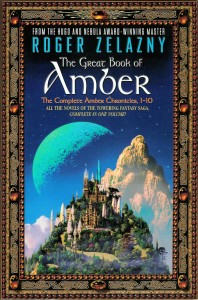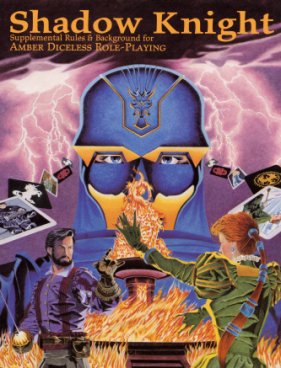You Should Be Playing…
Amber Diceless Role-playing Game
There is one true city on one true world, and it is called Amber. Founded by Oberon and ruled by his family, Amber stands where the slope of Mount Kolvir sweeps to the sea, on the edge of the Forest of Arden. It has stood since time immemorial, and it will remain eternal. Reflected from Amber is infinite Shadow, where all possible worlds can be found and created. All it takes is sufficient power and will to walk among Shadow, and among it find whatever it is that your heart desires. As far as any may wander, however, they cannot escape the pull of destiny and the machinations of their family…
The world of Amber was created by author Roger Zelazny in the 1970’s with the publication of Nine Princes in Amber. Zelazny went on to write ten novels and several short stories set in the vast multiverse of Shadow and Amber, filling the world with a cast of compelling characters. Drawn heavily on archetypes from Arthurian, Celtic, and Norse mythology, as well as Shakespeare’s plays and poetry, Zelazny wove an indelible story of intrigue, betrayal, and wonder.
 The Amber Diceless Roleplaying Game, written by the late Eric Wujcik, is an adaptation of those works. Forms of it have been in existence since the 80s, but it wasn’t published officially until 1991 by Phage Press. It has since passed into and out of publication several times, and in recent years it has been a difficult game to find in hard copy. Luckily, it can reliably be found available for download in PDF format from several retailers.
The Amber Diceless Roleplaying Game, written by the late Eric Wujcik, is an adaptation of those works. Forms of it have been in existence since the 80s, but it wasn’t published officially until 1991 by Phage Press. It has since passed into and out of publication several times, and in recent years it has been a difficult game to find in hard copy. Luckily, it can reliably be found available for download in PDF format from several retailers.
Amber DRPG offers the limitless multiverse of Amber to players both new and familiar with the setting. While often billed as a game for more advanced players, it is highly intuitive and very easy to learn. The mastery curve can be rather steep, however, and more experienced players in an Amber DRPG game have a distinct advantage.
The player characters of Amber DRPG are typically the grandchildren of Oberon, with the characters of the novels serving as their parents. The novels themselves are more or less treated as canon, but the narrators of the stories are highly unreliable. Game Masters are encouraged to expand upon the novel, and create their own version of events. Many Amber games even dispense with the canon Amberites entirely, creating their own children of Oberon instead.
Gameplay
Amber DRPG uses a combination of “Attributes”, “Powers”, and “Items” in a narrative format for conflict resolution. Players describe their character’s actions, to which the GM replies by describing their results. Conflict with other characters is usually determined by Attributes, with the character of the higher Attribute typically winning. Players are given a pool of points to build their characters, spending them on said Attributes, Powers, and Items. A character’s Powers represent their mastery of the fundamental forces of Shadow, giving them the ability to change their shape, cast magic, and warp reality to their desires. The three central Powers to Zelazny’s narrative are detailed with multiple levels of mastery, but several lesser powers are also available. Finally, characters possess Items that can take the form of anything from weapons to companions to entire realities that are part of their destiny. These Items become inherent to their character, and they serve as a signature to their character, such as Excalibur to the legend of Arthur, or the country of Latveria to the character of Dr. Doom from Marvel Comics.
The greatest success of Amber DRPG is how it captures the driving interpersonal conflicts of the novels. From the very start, players are encouraged to compete with each other as much as with the environment. Unlike most tabletop character generation, character creation in the game is done collectively with the Attribute Auction. Characters all start at roughly the power of a demigod, being stronger, faster, and more skilled than any human in history. As such, their chief competition is each other, and it is through the Attribute Auction that players decide which character is dominant in which Attribute. Players go back and forth, publicly spending points until there is an unchallenged top bid. The character with the top bid is virtually unbeatable in that Attribute. This starts the atmosphere of competition among the players, and is one of the main draws to the game.
At the root of the first five novels of the Chronicles of Amber is a struggle among the factions of Oberon’s children for his throne. The story builds from there, but it is the kernel of domestic struggle against one’s family that drives the assumed narrative of Amber DRPG. Players are encouraged through the Attribute Auction to create initial rivalries and alliances.
Bargaining becomes a factor between players, as a rival can be turned to an ally with an early offer of support in another auction, or previously silent player can cause a sudden upset by taking first with an unreasonably high bid after several characters have already invested into an Attribute. All characters start with the same pool of points, after all, and spending in the Auction limits the points left to spend on Powers and Items. The GM serves as the ultimate arbiter of the auction, with their word serving as the final note. Once the auction is closed for an Attribute, all bids are final.
After the Auction, players individually meet with the GM to construct their character with their remaining points. Powers and Items are purchased, and the finer details of the characters are decided. The sheer breadth of characters possible in Amber DRPG shines prominently. With the entirety of infinite Shadow at their disposal, new players are encouraged to create the character they have always wanted to play in other games but could not. Amber is big enough to hold them. Experienced players find themselves drawn towards certain archetypes in the narrative, but challenges can be found in nearly any sort of build. The available Powers are each radically different and cost intensive to the point of being nearly exclusive. Items offer a great deal of customization, perfect for adding the final touches on a character.
A Test of Mettle
While a great deal of a character is under the player’s control, the elements that are not come from the GM. In a standard game, players often cannot decide who their character’s parents are, and other such salient details. The key aspect to the private character building, however, is the element of mystery that it introduces to the game. There is a level of uncertainty to what other characters are fully capable of. Therefore, there’s an element of danger in any conflict with them. While all bids in the Auction are public and known, there is nothing forcing a character to bid in the Auction, and in some games, Attributes can be further increased during the private building session. Just as the Auction fosters a sense of competition between the players, the private character building fosters the uncertainty of motives and capacities of those players.
Amber DRPG certainly rewards creative planning. Whenever a character attempts an action, their player must describe their intended action to the GM. The more creative and imaginative the description, the better it is often received. Amber is a fantasy game first and foremost, and it deals with powerful characters across a palette of infinite possibilities. Once a player has grown comfortable with the act of describing their actions, their character often develops their own voice and style. Many games of Amber are known for keeping track of player quotes for amusement and posterity. There are not many games where a player can say, “I do something casual, like fly over on a dragon,” and have it be entirely accepted.
Quick thinking too is as essential to playing Amber DRPG as creative planning, and it is often through these tense moments that characters achieve victory when the odds are stacked against them. When dealing with a superior opponent in an Attribute, players are challenged to find a way to turn the conflict into one of an Attribute where their character has the advantage. Barring that, they may need to find a way out of the fight alive. If one cannot win in a sword fight, turn it into a gun fight. If that does not work, try knocking over a bookcase on them and running away. Because of this Game Mastering in Amber requires one to always think on their feet, and knowing when and how to reward a player for a truly innovative moment.
No Two Utopias Are The Same
That said, Amber is not without its flaws; any discussion of the game would be remiss without at least mentioning them. As alluded to earlier, there is a learning curve despite the game’s intuitive and creative play. Equally noteworthy though, is the issue of the player’s temperature. The fostering of inter-character conflict can lead to bruised feelings between players, and a good GM for this game needs to know when to step in and keep everyone cool.
 Slightly less dire, but certainly no less important, is that Amber DRPG has also been out or regular print since 2007. So, it can be very difficult to get a copy of outside of a digital format. For some, however, this issue is minor, as they don’t mind (or ever prefer) the PDF manuals.
Slightly less dire, but certainly no less important, is that Amber DRPG has also been out or regular print since 2007. So, it can be very difficult to get a copy of outside of a digital format. For some, however, this issue is minor, as they don’t mind (or ever prefer) the PDF manuals.
These flaws, however, are easily overcome with a forgiving GM, a mature group of players, and access to an online retailer.
Zelazny’s Chronicles of Amber was an amazing and compelling fantasy series that deconstructed its genre while embracing its wonder and possibility. Amber Diceless Roleplaying Game challenges players and Game Masters alike to play with the infinite possibilities of Zelazny’s narrative. In that, it succeeds in creating one of the most satisfying and immersive tabletop role-playing games released in the last 20 years. Everything and anything is literally possible in Shadow, but there is only one true city in one true world.
And that is why you should be playing Amber DRPG.
David Gordon is a regular contributor to the site. A storyteller by trade and avowed tabletop veteran, he is always on the lookout for creative tabletop games. He can be reached at dave@cardboardrepublic.com.
You can discuss this article and more on our forums!

